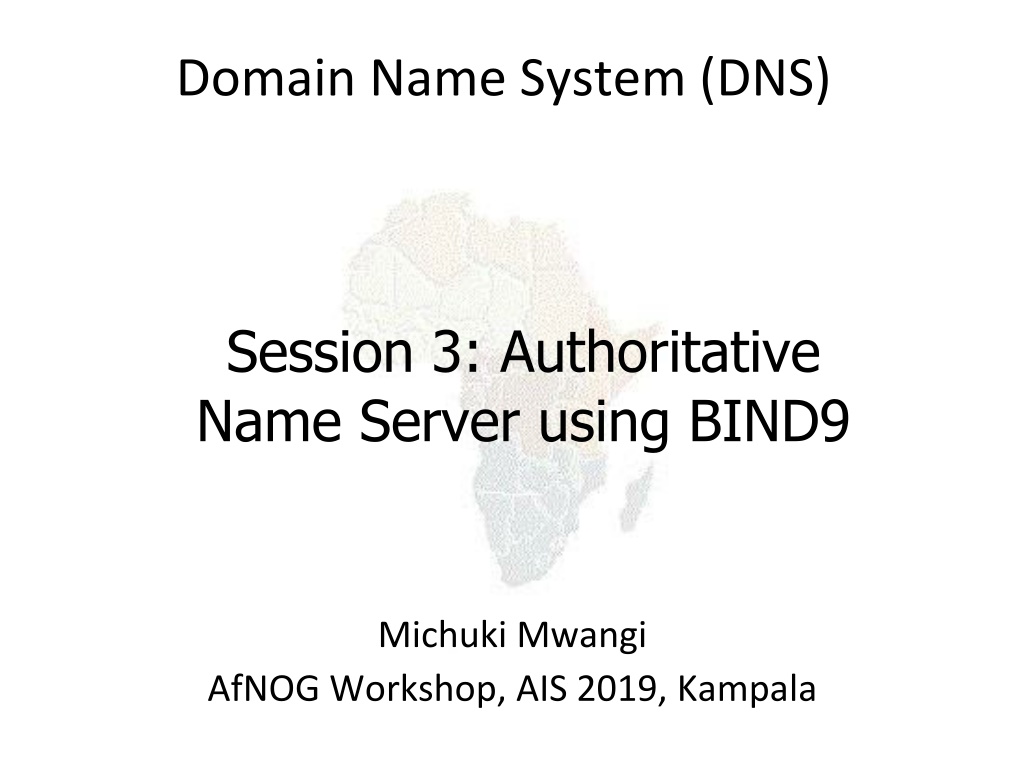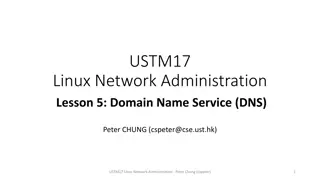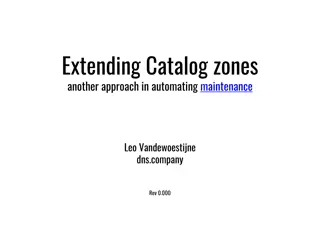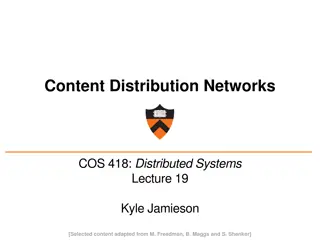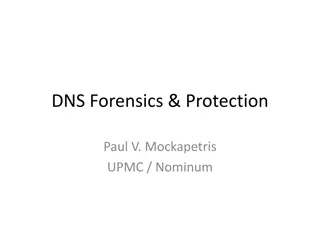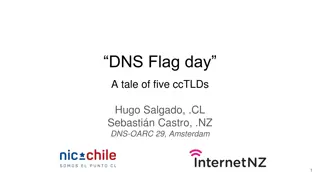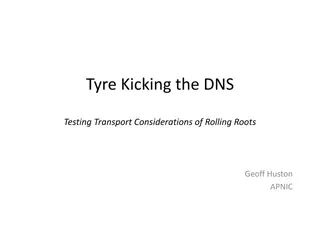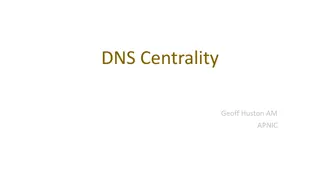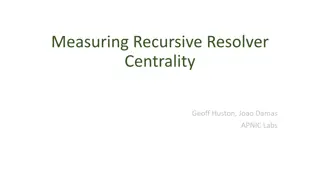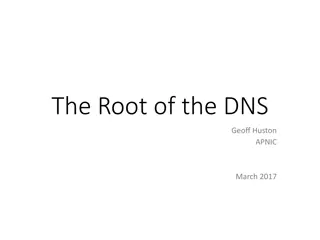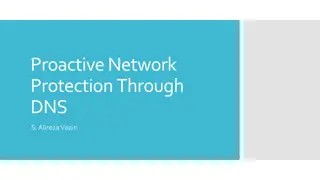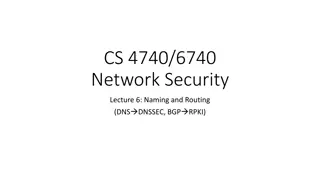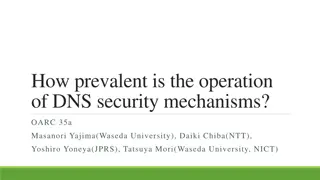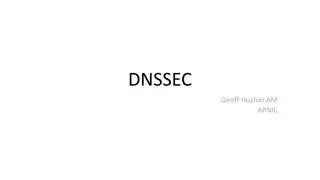Understanding DNS Replication with BIND9
Explore the intricacies of DNS replication using BIND9, including the role of authoritative name servers, the importance of serial numbers, and the process of data transfer between master and slave servers. Discover insights on maintaining consistency in zone data to ensure smooth DNS operations.
Download Presentation

Please find below an Image/Link to download the presentation.
The content on the website is provided AS IS for your information and personal use only. It may not be sold, licensed, or shared on other websites without obtaining consent from the author. Download presentation by click this link. If you encounter any issues during the download, it is possible that the publisher has removed the file from their server.
E N D
Presentation Transcript
Domain Name System (DNS) Session 3: Authoritative Name Server using BIND9 Michuki Mwangi AfNOG Workshop, AIS 2019, Kampala
Recap DNS is a distributed database Stub asks Resolver for information Resolver traverses the DNS delegation tree to find Authoritative nameserver which has the information requested Bad configuration of authoritative servers can result in broken domains
DNS Replication For every domain, we need more than one authoritative nameserver with the same information (RFC 2182) Data is entered in one server (Master) and replicated to the others (Slave(s)) Outside world cannot tell the difference between master and slave NS records are returned in random order for equal load sharing Used to be called "primary" and "secondary"
Slaves connect to Master to retrieve copy of zone data The master does not "push" data to the slaves Slave Master Slave
When does replication take place? Slaves poll the master periodically - called the "Refresh Interval" - to check for new data Originally this was the only mechanism With new software, master can also notify the slaves when the data changes Results in quicker updates The notification is unreliable (e.g. network might lose a packet) so we still need checks at the Refresh Interval
Serial Numbers Every zone file has a Serial Number Slave will only copy data when this number INCREASES Periodic UDP query to check Serial Number If increased, TCP transfer of zone data It is your responsibility to increase the serial number after every change, otherwise slaves and master will be inconsistent
Recommended serial number format: YYYYMMDDNN YYYY = year MM = month (01-12) DD = day (01-31) NN = number of changes today (00-99) e.g. if you change the file on 23rd April 2007, the serial number will be 2008052700. If you change it again on the same day, it will be 2008052701.
Serial Numbers: Danger 1 If you ever decrease the serial number, the slaves will never update again until the serial number goes above its previous value RFC1912 section 3.1 explains a method to fix this problem At worst, you can contact all your slaves and get them to delete their copy of the zone data
Serial Numbers: Danger 2 Serial no. is a 32-bit unsigned number Range: 0 to 4,294,967,295 Any value larger than this is silently truncated e.g. 20080527000 (note extra digit) = 4ACE48698 (hex) = ACE48698 (32 bits) = 2900657816 If you make this mistake, then later correct it, the serial number will have decreased
Configuration of Master /etc/bind/named.conf.local points to zone files (manually created) containing your RRs Choose a logical place to keep them e.g. /var/cache/bind/master/tiscali.co.uk or /var/cache/bind/master/uk.co.tiscali zone "example.com" { type master; file "master/example.com"; allow-transfer { 192.188.58.126; 192.188.58.2; }; };
Configuration of Slave named.conf points to IP address of master and location where zone file should be created Zone files are transferred automatically Don't touch them! zone "example.com" { type slave; masters { 192.188.58.126; }; file "slave/example.com"; allow-transfer { none; }; };
Master and Slave It's perfectly OK for one server to be Master for some zones and Slave for others That's why we recommend keeping the files in different directories /var/cache/bind/master/ /var/cache/bind/slave/ (also, the slave directory can have appropriate permissions so that the daemon can create files)
allow-transfer { ... } Remote machines can request a transfer of the entire zone contents By default, this is permitted to anyone Better to restrict this You can set a global default, and override this for each zone if required options { allow-transfer { 127.0.0.1; }; };
Structure of a zone file Global options $TTL 1d Sets the default TTL for all other records SOA RR "Start Of Authority" Housekeeping information for the zone NS RRs List all the nameservers for the zone, master and slaves Other RRs The actual data you wish to publish
Format of a Resource Record www 3600 IN A 212.74.112.80 Domain TTL Class Type Data One per line (except SOA can extend over several lines) If you omit the Domain Name, it is the same as the previous line TTL shortcuts: e.g. 60s, 30m, 4h, 1w2d If you omit the TTL, uses the $TTL default value If you omit the Class, it defaults to IN Type and Data cannot be omitted Comments start with SEMICOLON (;)
Shortcuts If the Domain Name does not end in a dot, the zone's own domain ("origin") is appended A Domain Name of "@" means the origin itself e.g. in zone file for example.com: @means example.com. wwwmeans www.example.com.
If you write this... $TTL 1d @ SOA ( ... ) NS ns0 NS ns0.as9105.net. ; Main webserver www A 212.74.112.80 MX 10 mail ... it becomes this example.com. 86400 IN SOA ( ... ) example.com. 86400 IN NS ns0.example.com. example.com. 86400 IN NS ns0.as9105.net. www.example.com. 86400 IN A 212.74.112.80 www.example.com. 86400 IN MX 10 mail.example.com.
Format of the SOA record $TTL 1d @ 1h IN SOA ns1.example.net. joe.pooh.org. ( 2004030300 ; Serial 8h ; Refresh 1h ; Retry 4w ; Expire 1h ) ; Negative IN NS ns1.example.net. IN NS ns2.example.net. IN NS ns1.othernetwork.com.
Format of the SOA record ns1.example.net. hostname of master nameserver jabley.hopcount.ca. E-mail address of responsible person, with "@" changed to dot, and trailing dot Serial number Refresh interval How often Slave checks serial number on Master Retry interval How often Slave checks serial number if the Master did not respond
Format of the SOA record (cont) Expiry time If the slave is unable to contact the master for this period of time, it will delete its copy of the zone data Negative / Minimum Old software used this as a minimum value of the TTL Now it is used for negative caching: indicates how long a cache may store the non-existence of a RR RIPE-203 has recommended values http://www.ripe.net/ripe/docs/dns-soa.html
Format of NS records List all authoritative nameservers for the zone - master and slave(s) Must point to HOSTNAME not IP address $TTL 1d @ 1h IN SOA ns1.example.net. joe.pooh.org. ( 2004030300 ; Serial 8h ; Refresh 1h ; Retry 4w ; Expire 1h ) ; Negative IN NS ns1.example.net. IN NS ns2.example.net. IN NS ns1.othernetwork.com.
Format of other RRs IN A 1.2.3.4 IN MX 10 mailhost.example.com. The number is a "preference value". Mail is delivered to the lowest-number MX first Must point to HOSTNAME not IP address IN CNAME host.example.com. IN PTR host.example.com. IN TXT "any text you like"
When you have added or changed a zone file: Remember to increase the serial number! named-checkzone example.com \ /var/cache/bind/master/example.com bind 9 feature reports zone file syntax errors; correct them! named-checkconf reports errors in named.conf rndc reload or: rndc reload example.com tail /var/log/messages
These checks are ESSENTIAL If you have an error in named.conf or a zone file, named may continue to run but will not be authoritative for the bad zone(s) You will be lame for the zone without realising it Slaves will not be able to contact the master Eventually (e.g. 4 weeks later) the slaves will expire the zone Your domain will stop working
Other checks you can do dig +norec @x.x.x.x example.com. soa Check the AA flag Repeat for the master and all the slaves Check the serial numbers match dig @x.x.x.x example.com. axfr "Authority Transfer" Requests a full copy of the zone contents over TCP, as slaves do to master This will only work from IP addresses listed in the allow-transfer {...} section
So now you have working authoritative nameservers! But none of this will work until you have delegation from the domain above That is, they put in NS records for your domain, pointing at your nameservers You have also put NS records within the zone file The two sets should match
TOP TEN ERRORS in authoritative nameservers All operators of auth nameservers should read RFC 1912 Common DNS Operational and Configuration Errors And also RFC 2182 Selection and Operation of Secondary DNS servers
1. Serial number errors Forgot to increment serial number Incremented serial number, then decremented it Used serial number greater than 232 Impact: Slaves do not update Master and slaves have inconsistent data Caches will sometimes get the new data and sometimes old - intermittent problem
2. Comments in zone files starting '#' instead of ';' Syntax error in zone file Master is no longer authoritative for the zone Slaves cannot check SOA Slaves eventually expire the zone, and your domain stops working entirely Use "named-checkzone" Use "tail /var/log/messages"
3. Other syntax errors in zone files e.g. omitting the preference value from MX records Same impact
4. Missing the trailing dot ; zone example.com. @ IN MX 10 mailhost.example.com becomes @ IN MX 10 mailhost.example.com.example.com. ; zone 2.0.192.in-addr.arpa. 1 IN PTR host.example.com becomes 1 IN PTR host.example.com.2.0.192.in-addr.arpa.
5. NS or MX records pointing to IP addresses They must point to hostnames, not IP addresses Unfortunately, a few mail servers do accept IP addresses in MX records, so you may not see a problem with all remote sites
6. Slave cannot transfer zone from master Access restricted by allow-transfer {...} and slave not listed Or IP filters not configured correctly Slave will be lame (non-authoritative)
7. Lame delegation You cannot just list any nameserver in NS records for your domain You must get agreement from the nameserver operator, and they must configure it as a slave for your zone At best: slower DNS resolution and lack of resilience At worst: intermittent failures to resolve your domain
8. No delegation at all You can configure "example.com" on your nameservers but the outside world will not send requests to them until you have delegation The problem is hidden if your nameserver is acting both as your cache and as authoritative nameserver Your own clients can resolve www.example.com, but the rest of the world cannot
9. Out-of-date glue records See later
10. Not managing TTL correctly during changes e.g. if you have a 24 hour TTL, and you swing www.example.com to point to a new server, then there will be an extended period when some users hit one machine and some hit the other Follow the procedure: Reduce TTL to 10 minutes Wait at least 24 hours Make the change Put the TTL back to 24 hours
Practical Create a new domain Set up master and slave nameservice Obtain delegation from the domain above Test it
